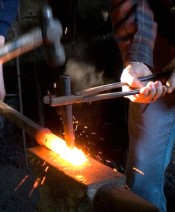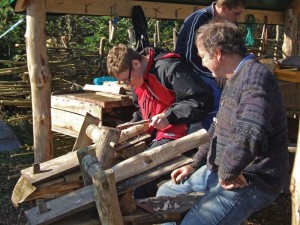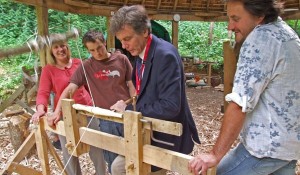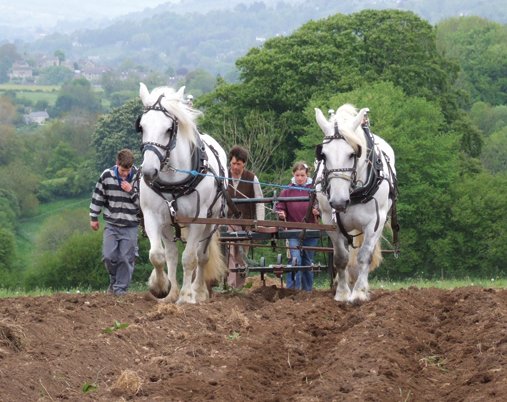Waldorf News
A New Inspiration for Education: A report from the Western Waldorf Educators Conference featuring Aonghus Gordon

By STEPHEN PAYNE
The Western Waldorf Educators Conference of 2012 at Rudolf Steiner College (RSC) in Fair Oaks, California, artfully wove practical craft skills, movement, and lectures into three days entitled “A New Inspiration for Education.” RSC invited Aonghus Gordon of Ruskin Mill Educational Trust from England and a team of educators and crafts people to present workshops in various disciplines such as green woodworking, weaving, felting, iron forging, biodynamic gardening, soap making, painting, cooking and food preservation, healing balms, singing and movement. Unlike most conferences, emphasis was placed on the hands-on experiences found in the craft workshops. They were held twice each day in the key timeslots — first each morning and after the lunch break in the afternoon. To balance the work with our hands, Mr. Gordon delivered keynote lectures throughout the three days. Having hours to spend with their hands actively creating, participants gained the opportunity for deep reflection on how we move in space with purpose in service.
Ruskin Mill Educational Trust implemented a practical arts curriculum starting in 1982. Working with teens and young adults with complex learning and behavioral difficulties, many of whom have autistic spectrum conditions, students have benefited from the practical skills therapeutic education. Mr. Gordon and the Educational Trust have discovered, through the learning of practical-craft skills, the engagement of will-intentions and movement-intentions facilitate well-being and social health. The transformation of matter requires sensory engagement and lawful movement, strengthening a relationship to the three planes of space, serving as a powerful aide toward incarnation. A new moral aesthetic emerges that inspires and awakens one’s self-worth and their relationship to the world. Our ability to consciously penetrate our dimensional existence with movement builds our ability to move through life. As Mr. Gordon expressed, “Meeting resistance in matter helps us move through our own inner resistance. The blacksmith hammers out his own stiffness. The carpenter smooths her own rough edges.”
Mr. Gordon shared many useful insights from his years of guiding young people to discover themselves and their true potential. He explained with case study examples the process of consideration he undergoes when assessing the needs of a student. Through much thought and contemplation he takes into account a student’s past and present demeanor to gain a glimpse as to their craft based pedagogical need. He recommends aligning appropriate craft offerings with the twelve senses.
Upper Senses
Ego: Healing Balms, Homeopathic Medicine, Biodynamic Medicine
Concept: Painting, Natural Dyes
Speech: Singing
Hearing: Beekeeping, Animal Husbandry
Middle Senses
Warmth: Soapmaking, Herbal Care
Sight: Weaving
Taste: Cooking, Food Preservation
Smell: Cooking, Felting
Lower Senses
Balance: Glassworks, Biodynamics
Movement: Woodworking, Carpentry, Weaving
Life: Gardening, Animal Husbandry
Touch: Clay, Iron Forge, Felting
This is just an example and may vary from the many schools and colleges Mr. Gordon has helped to create over the last 30 years. He suggests, “walking in the posture and gait of the student you are observing.” He also said, “We build the higher senses from the foundation of the lower four. The lower four are best developed by a curriculum in a practical outdoor active craft.”
Research commissioned by RMET, conducted by Aric Sigman and documented in an article titled Practically Minded: The Benefits and Mechanisms Associated with a Craft-Based Curriculum, has shown that using tools in craft activities uses and strengthens widely distributed highly interactive brain cell networks that go far beyond the skills of hand, eye, and muscle coordination related to the craft. Tool use involves and stimulates social, cognitive, perceptual and motor processes. Mirror neurons are specialized brain cells involved in observational learning, copying by example, and are activated with handcraft tool use.
 Some other advantages found by Dr. Sigman with a practical craft-based curriculum is that it supports and advances emotional and intellectual functioning as well as provide experiences for students in creativity, independence, determination, and developing problem-solving skills. Benefits are broad and numerous and are more than the product from a specific skill. A practical craft-based curriculum also develops a general capacity to function and work in other areas. Such a curriculum develops a confidence for adaptability, a sense of control over the hands that provides a sense of control over oneself. This self-empowerment helps strengthen emotional stability, behavioral and mental health. This emotional empowerment lowers association with suffering from anxiety, depression and other psychopathologies. A craft-based curriculum also builds patience and focus that is vital to impulse control and strengthens within oneself sustained attention, self-regulation, and defers gratification. With a list of benefits this long, there is no doubt hand-crafts are for everyone and necessary in our schools in this day and age.
Some other advantages found by Dr. Sigman with a practical craft-based curriculum is that it supports and advances emotional and intellectual functioning as well as provide experiences for students in creativity, independence, determination, and developing problem-solving skills. Benefits are broad and numerous and are more than the product from a specific skill. A practical craft-based curriculum also develops a general capacity to function and work in other areas. Such a curriculum develops a confidence for adaptability, a sense of control over the hands that provides a sense of control over oneself. This self-empowerment helps strengthen emotional stability, behavioral and mental health. This emotional empowerment lowers association with suffering from anxiety, depression and other psychopathologies. A craft-based curriculum also builds patience and focus that is vital to impulse control and strengthens within oneself sustained attention, self-regulation, and defers gratification. With a list of benefits this long, there is no doubt hand-crafts are for everyone and necessary in our schools in this day and age.
Waldorf education is one of many streams applying the theme of learning through freedom and empowerment. Mr. Gordon quoted Rudolf Steiner early in his lectures, “There is no more beautiful symbol of human freedom than the human arm and hand.” Rudolf Steiner was highly interested in the healing which occurs through the transformation of matter in the arts and practical crafts curriculum. Steiner often addressed the humility of service and how the practical arts have within them the law of healing the human soul through the service of love.
 Participants grasped the possibilities of all the working hand can accomplish internally and externally. Also recognizing that crafts live and serve in the natural setting of the farm, Agriculture has a foundational presence in the development of people and culture. There are countless possibilities on the farm and in the Biodynamic movement today—the study of phenomenology and alchemistry, social awareness and activism, a home for primary and secondary education—all while serving the community producing staples and sustenance. Mr. Gordon highlighted the importance of the farm towards the end of the conference when stating, “The Biodynamic Farm is the new university. Practical experience subconsciously inner layers one’s ability to self-initialize. If I can change matter, I matter.”
Participants grasped the possibilities of all the working hand can accomplish internally and externally. Also recognizing that crafts live and serve in the natural setting of the farm, Agriculture has a foundational presence in the development of people and culture. There are countless possibilities on the farm and in the Biodynamic movement today—the study of phenomenology and alchemistry, social awareness and activism, a home for primary and secondary education—all while serving the community producing staples and sustenance. Mr. Gordon highlighted the importance of the farm towards the end of the conference when stating, “The Biodynamic Farm is the new university. Practical experience subconsciously inner layers one’s ability to self-initialize. If I can change matter, I matter.”
Stephen Payne is the farmer at the Sacramento Waldorf School and tends the 3.5 acre biodynamic garden there. His article originally appeared on the Biodynamics Blog of the Biodynamic Association. To view the article at source, click here.
 Summer Programs - Culminating Class Trips
Summer Programs - Culminating Class Trips Apply Today: New Cohort Starts Nov. 2025
Apply Today: New Cohort Starts Nov. 2025 Bay Area Teacher Training
Bay Area Teacher Training The Journey is Everything
The Journey is Everything Immersive Academics and Arts
Immersive Academics and Arts The Art of Administration and Leadership
The Art of Administration and Leadership Middle School Science With Roberto Trostli
Middle School Science With Roberto Trostli Jamie York Books, Resources, Workshops
Jamie York Books, Resources, Workshops Association for a Healing Education
Association for a Healing Education Storytelling Skills for Teachers
Storytelling Skills for Teachers Transforming Voices Worldwide
Transforming Voices Worldwide Everything a Teacher Needs
Everything a Teacher Needs Art of Teaching Summer Courses 2025
Art of Teaching Summer Courses 2025 Train to Teach in Seattle
Train to Teach in Seattle Roadmap to Literacy Books & Courses
Roadmap to Literacy Books & Courses Waldorf-inspired Homeschool Curriculum
Waldorf-inspired Homeschool Curriculum Dancing for All Ages
Dancing for All Ages Bringing Love to Learning for a Lifetime
Bringing Love to Learning for a Lifetime ~ Ensoul Your World With Color ~
~ Ensoul Your World With Color ~ Grade Level Training in Southern California
Grade Level Training in Southern California Space speaks. Its language is movement.
Space speaks. Its language is movement. Quality Education in the Heartland
Quality Education in the Heartland Caring for All Stages of Life
Caring for All Stages of Life Full-Time Teacher Education
Full-Time Teacher Education Flexible preparation for your new grade
Flexible preparation for your new grade Waldorf EC Training & Intensives in Canada
Waldorf EC Training & Intensives in Canada Discovering the Wisdom of Childhood
Discovering the Wisdom of Childhood RSS Feeds
RSS Feeds